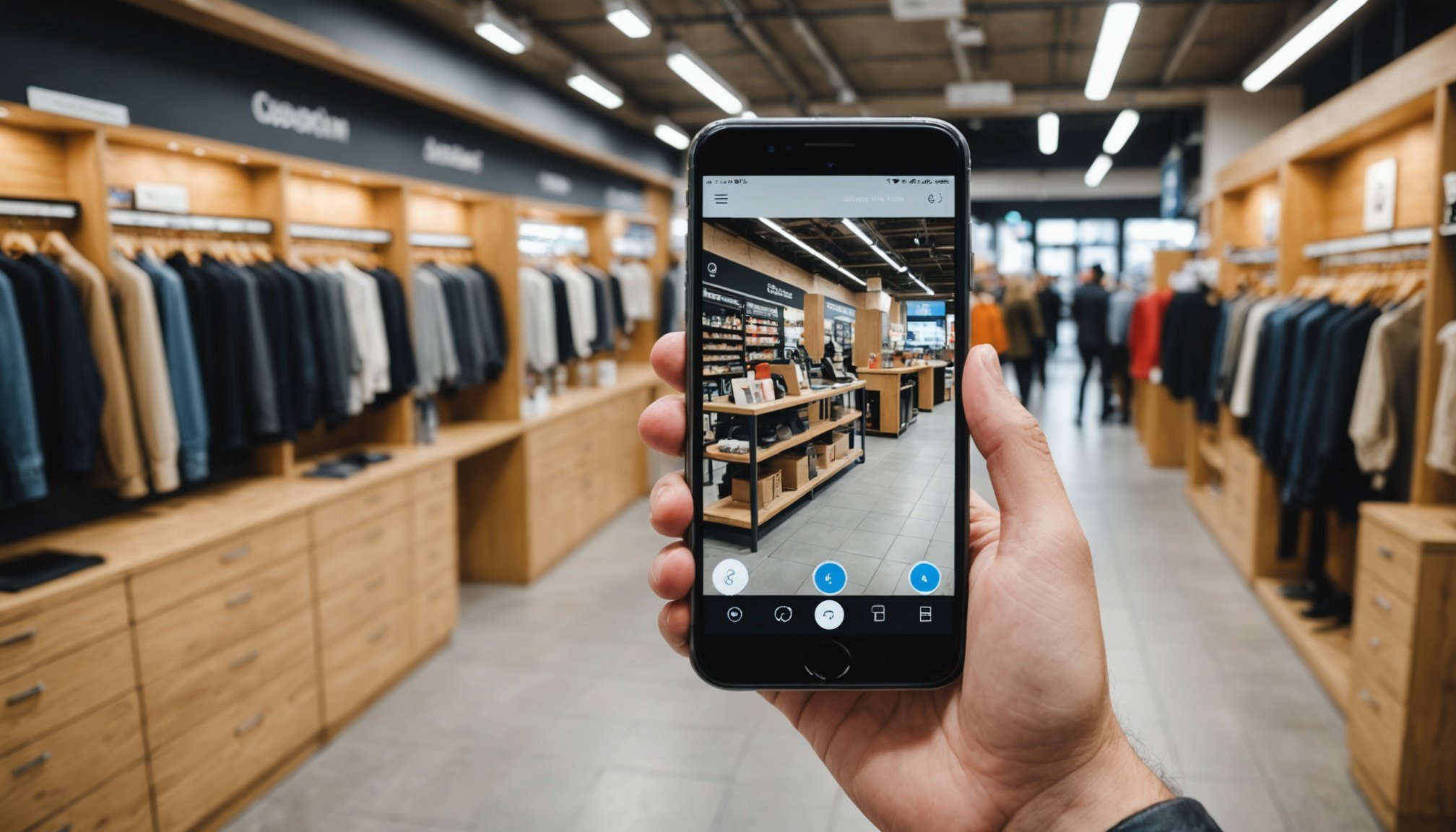Overview of Augmented Reality in Retail
Augmented Reality (AR) is a revolutionary technology that superimposes digital content onto the physical world, providing a seamless blend of virtual and real experiences. It first gained traction in the early 2010s, offering novel ways for businesses to engage with customers. AR in the retail sector began as a novelty but has now evolved into a vital tool for enhancing consumer interaction.
In recent years, UK retail trends have seen significant adoption of augmented reality, with many retailers integrating this technology to improve customer engagement. Current studies show that nearly 70% of UK retailers are experimenting with or have implemented AR solutions, reflecting a growing confidence in its potential to drive sales and improve the customer journey.
Also to read : Unlocking Efficiency: AI Strategies for Enhanced Stock Management in UK Grocery Stores
The role of AR in retail is multifaceted, primarily aiming to elevate the shopping experience. By allowing customers to virtually try products, visualize items in their intended environment, or interact with digitally-enhanced promotional content, AR offers a more immersive and personalized shopping experience. This interactive element not only aids decision-making but also boosts customer satisfaction, setting a new standard in the competitive UK retail market.
Benefits of Augmented Reality for Customer Engagement
Augmented Reality (AR) offers a transformative edge in customer engagement, particularly in the retail sector. By enhancing product visualization, AR allows customers to experience products in their intended context, such as virtually placing a piece of furniture in their home or trying on clothes. This immersive experience not only aids decision-making but also encourages interaction, as customers engage with products more intuitively.
Also to see : Unlocking Success: Strategies for Promoting UK Specialty Cheeses in Post-Brexit Europe
Moreover, AR improves the overall customer experience and satisfaction. Shoppers can explore products with greater detail and confidence, reducing uncertainty and enhancing the shopping journey. This personalized experience often exceeds traditional shopping, leading to greater customer loyalty and enjoyment.
Another significant benefit of AR in retail is its potential to boost sales and conversion rates. With precise visualization, buyers are better informed and more likely to proceed with purchases, reducing cart abandonment. This results from the added confidence AR provides, assuring customers of their purchasing decisions.
Overall, integrating AR into a retail strategy enhances customer engagement. It meets modern consumer needs and opens up new avenues for retailers to connect with and satisfy their audience, paving the way for greater business success and innovation.
Successful Case Studies in the UK Retail Sector
Delving into the world of Augmented Reality (AR), several UK retailers have redefined their marketing strategies through successful implementations of AR technologies.
Leading Retailers Leveraging AR
High-profile retailers like John Lewis and ASOS have emerged as front-runners in adopting AR. These retailers have successfully utilised AR to enhance the customer experience, allowing shoppers to visualise products in their own environment before making a purchase. This not only boosts customer satisfaction but also drives sales growth.
Innovative AR Campaigns
Campaigns such as ASOS’s virtual catwalk have been proven effective, showcasing how clothes look in motion through smartphones. This innovative use of AR encourages online shopping engagement by bridging the gap between physical stores and digital experiences. Similarly, John Lewis implemented AR for home furnishings, allowing customers to see how items fit into their living spaces.
Key Takeaways from Case Studies
- Customer Engagement: AR campaigns have significantly increased customer interaction by providing an interactive shopping experience.
- Sales Conversion: Implementations have shown a direct link to improved sales conversion rates.
- Feedback: Retailers acknowledge that AR provides invaluable data on customer preferences, aiding in refining marketing strategies.
Practical Applications of Augmented Reality in Retail
Augmented Reality (AR) technology is reshaping the retail landscape by offering practical applications that enhance the shopping experience. One such innovation is virtual try-ons in fashion retail stores. Shoppers can now try on clothes and accessories digitally, which minimises the need to physically test each item. This not only saves time but also helps customers make more confident purchases.
Fashion retailers are just a piece of the puzzle. Interactive store displays use AR to provide customers with enhanced in-store navigation. By using their smartphones or AR glasses, shoppers can receive real-time directions, learn about sales, and even get detailed product info while walking through the store. This creates a seamless shopping journey and keeps customers informed and engaged.
Also, AR applications offer product demonstrations that take consumer interaction to new heights. Customers can view animated product features and specifications superimposed in their real-world environment. This hands-on experience enables them to understand products more fully, aiding in decision-making by delivering richer product information.
Together, these applications signify a transformative shift in how consumers interact with retail environments, creating a more personalised and efficient shopping experience facilitated by AR technology.
Challenges and Considerations for Implementing AR
Implementing Augmented Reality (AR) comes with its unique set of challenges. One major consideration is the technical challenges and infrastructure requirements. For AR to function smoothly, it demands robust hardware and software systems, which may necessitate significant upgrades to existing infrastructure. This can be a daunting task for businesses without current technological capabilities.
Cost is another crucial element when considering AR implementation. The cost implications of AR technology adoption can be substantial, including not only the initial investment but also ongoing maintenance and updates. It is vital for businesses to evaluate whether the benefits justify the expenses in the long run.
User acceptance and the learning curve for customers pose another hurdle. As AR represents a shift from traditional methods, it requires users to adapt to new technology. This could potentially deter customers who are less tech-savvy, thus impacting user engagement. Offering comprehensive training and support can aid in overcoming this barrier, ensuring that consumers feel comfortable and confident using AR solutions.
Tackling these challenges requires strategic planning and resource allocation, allowing businesses to fully harness the potential of AR in enhancing consumer experiences and operational efficiency.
Future Trends in Augmented Reality for Retail
As augmented reality (AR) technologies advance, several emerging trends are poised to reshape the retail sector. One significant development is the use of AR for hyper-personalised shopping experiences. Retailers are leveraging AR innovations to customise interactions, creating a more engaging shopping environment that is both interactive and tailored.
Predictions in the AR landscape indicate that immersive experiences will become the norm. Virtual try-ons, for instance, allow consumers to visualise products such as clothing or furniture in real time before making a purchase. This trend not only enhances customer satisfaction by reducing uncertainty but also minimises return rates, positively impacting retailer profits.
Consumer behaviour is expected to shift with the incorporation of AR technologies. There will likely be an increase in demand for mobile AR apps, as shoppers prefer convenience and instant information access. Specifically, shoppers could adapt to using AR to inform purchasing decisions, blending the virtual and physical worlds seamlessly.
Furthermore, retailers investing in AR innovations are creating competitive advantages. As AR evolves, these technologies are set to redefine customer expectations, cementing AR as an essential component in the future of retail.










